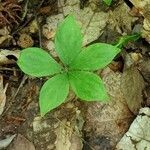Herbs, singly or rarely in small clumps, short-rhizomatous, 4–25 cm. Stems pale grayish green, glaucous; scales 2–4, near soil line, white to light green. Leaves pale grayish green; blade elliptic-obovate, 17–85 × 8–40 mm, apex acuminate, glaucous when young. Flowers subsessile, without nectar and fragrance; sepals arching, green to light green, linear-oblanceolate, 12–25 × 2–3 mm; petals light green, oblanceolate, 12–18 × 2–4 mm; lip light yellowish green to pale greenish white, streaked with green, obovate, 11–16 × 4–5 mm, lateral lobes narrowly triangular, margins involute, middle lobe rounded, margins slightly revolute, undulate; callus yellowish green, longitudinal, becoming elongate, with fleshy, wartlike papillae toward apex; column 8–10 mm; ovary 10–15 mm; rostellar flap reduced. Capsules 12–28 × 2–10 mm; pedicel of mature capsule elongating to 5–17(–20, rarely) mm. 2n = 18.
More
Not colonial, the individuals few and scattered; herbage glaucous; stem 1.5–2.5 cm; lvs as in no. 1 [Isotria verticillata (Willd.) Raf.]; peduncle 1–1.5 cm, fls selfed, inodorous, light green or yellow-green or partly whitish, without guide-lines; sep 1.2–2.5 cm; pet 1.3–1.7 cm; lip 1–1.5 cm, less emarginate and ornate; 2n=18. Open stands of second-growth hardwoods or pine-hardwoods; irregularly at widely scattered stations from s. Me. to N.C., w. to s. Ont., Mich. and Mo. May, June. Our rarest orchid.


